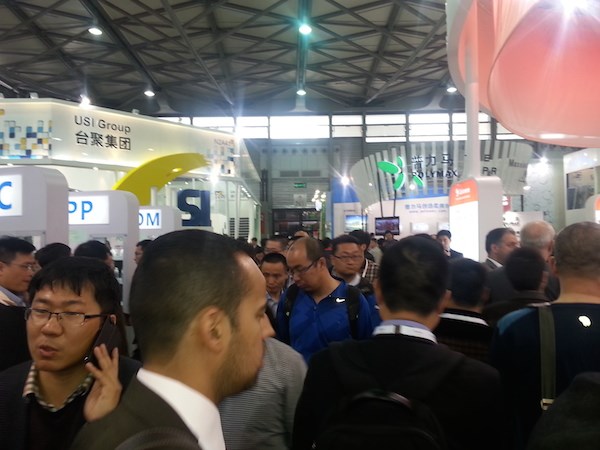Chinaplas keeps growing even as China slows down
Every show, for more than three decades now, Chinaplas has grown.

It’s a remarkable stat made all the more impressive by the fact that the rest of China, for the first time in a long time, really is slowing down. Stanley Chu (pictured above), chairman of Chinaplas organizer, Adsale Exhibition Services Ltd., looked back at the inaugural Chinaplas, held in Beijing in 1983, before talking to gathered trade press about the latest iteration, No. 28, to be held this week in Shanghai.
Thirty-one years ago the fair covered a few thousand square meters with around 100 exhibitors, 95% of which came from outside China.
“At that time in early ‘80s, China could hardly come up with decent machines or chemicals for exhibiting,” Chu reflected, before noting that after “30 years of hard work,” Chinaplas now covers 230,000-m2, with more than 3000 companies exhibiting and over 3000 sets of machinery, about half of which were manufactured in China. During four days of show, Adsale expects 120,000 visitors, 30,000 of whom will be from other countries.
Chinaplas grows, China pauses
This enormous show takes place in the broader economic context of a country where double-digit GDP expansion is no longer a given and policy makers question the environmental and societal costs of explosive growth.
Chu noted that a decade ago, exports contributed 24% to China’s GDP, but in the past two years, that figure has shifted to -2%, as the country became a net importer.
“China had a tremendous competitive advantage having low-cost labor and low-cost land,” Chu said, “but this advantage was built on the sacrifice of environment.” Since that time, Chu said the government has more strictly enforced environmental regulations, while wages and the Chinese currency have risen, forcing the plastics industry in the country, and its trademark show, to also evolve.
“The low-end manufacturers are hardly surviving in China today,” Chu said. “The manufacturing industry has to go for upgrading; it has to go for quality; it has to go for automation; and this is exactly what we want to see during Chinaplas, because the manufacturers are now facing problems, and we're offering solutions. We're addressing the problems manufactures are facing these days.”
More exhibitors, smaller booths
While the show has grown, the average exhibitor’s booth size has shrunk, as the fair seeks to accommodate new entrants, adding around 400 new exhibitors in 2014.
“On average, past exhibitors had to cut down space by 17%,” Chu said, so that if they wanted 100 square meters they can only get 83. That’s done with the goal of having 15-20% new exhibitors at each show “because buyers want to see new faces and find new contact and new suppliers,” Chu said.
“We do not know when Chinaplas will stop from expanding,” Chu said, “but it's still moving ahead, supported by strong demand of the market and technology on display at show.”

















